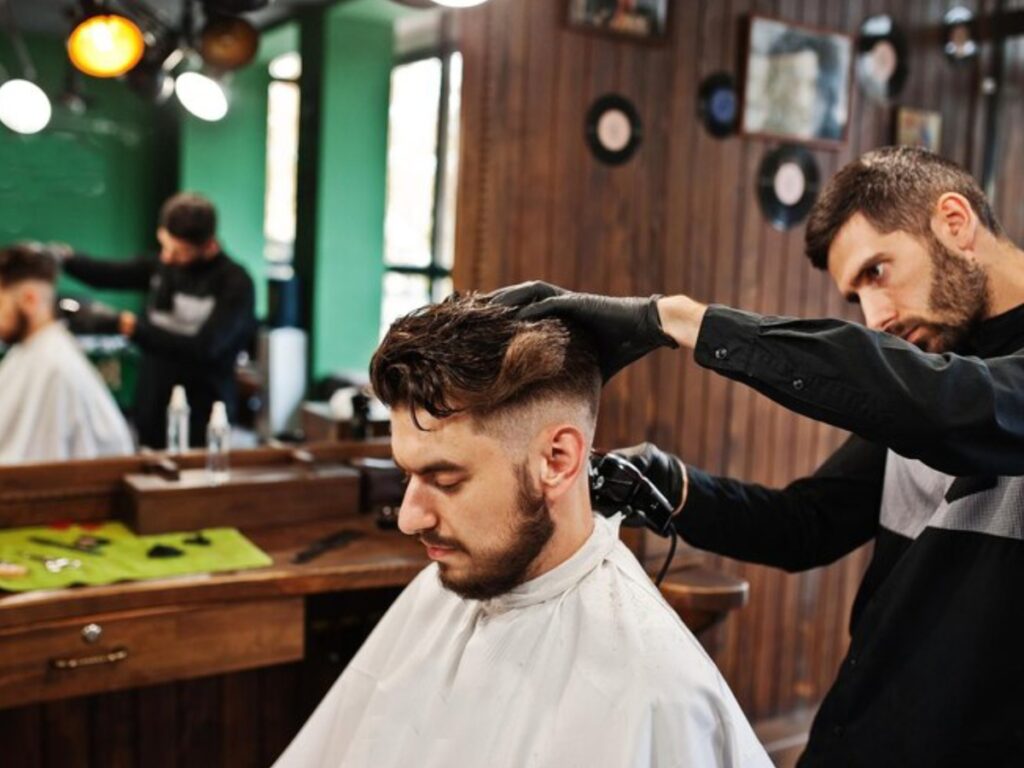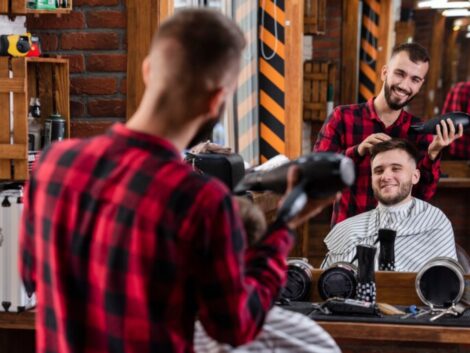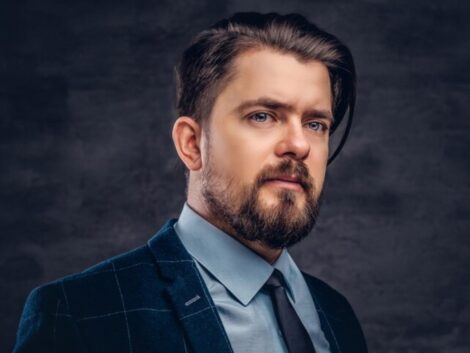What-are-some-common-techniques-used-in-mens-haircuts ?Some common techniques used in men’s haircuts include tapering, fading, undercut, scissor cut, crew cut, razor fade, and more. These haircut techniques are executed by hairstylists and require a lot of practice and training. In this article, we will dive deep into various hairstyle techniques for men’s haircuts and how they evolved over time.
How do hairstylists achieve the perfect fade haircut?
A faded haircut is a popular men’s hairstyle that features a seamless transition from short hair at the sides to longer hair on the top middle. It gives your face a clean and sharp look.
Achieving the perfect fade haircut requires precision and skill, which a hair stylist must master. Here is a brief description of the whole process:
- Preparing your hair: The hairstylist will start by washing and drying your hair to ensure it’s clean and manageable.
- Doing the clipping: The stylist selects the appropriate clipper guard size based on the type of fade you want. For example, a #1 guard will create a shorter fade. They will first trim the sides and back of your head following the hair’s natural growth pattern.
- Creating a guideline: To create the initial guideline for the fade, the stylist will use a shorter guard or no guard at all (usually a 0.5 or 1). Then, they will trim a horizontal line around the head, usually an inch or two above your ear.
- Blending the fade: The stylist will then use progressively longer guard sizes. This will gradually blend the hair from the shorter guideline to the longer one on top. For this, they will use tapering and fading techniques carefully.
- Detailing: The stylist will work on the neckline, sideburns, and around the ears to make sure these areas are neat and well-defined.
- Final styling: The stylist finishes the haircut by styling the hair on top as desired. They can use products like pomade, wax, or gel to achieve the final look you want.
What are the tools and equipment used in modern men’s haircuts?
Modern men’s haircuts have evolved greatly from the traditional ones because more modern tools have been introduced to the game. Here are some of them:
- Electric clippers: Electric clippers are used for cutting and blending hair at various lengths. They come with different guard attachments for controlling this length.
- Electric Trimmers: These are smaller clippers. They are used for more detailed work around the edges and sideburns.
- Scissors: Hair-cutting scissors, also known as shears, are used for more precise cutting. It is also used for texturizing.
- Combs: Different haircut combs serve different purposes. For example, wide-tooth combs are used for detangling, and fine-tooth combs are used for precision cutting.
- Blow Dryer: Hair dryers are used to style and set hair in place, especially for hairstyles that require volume or specific shapes.
- Razors: Straight razors or disposable razors are commonly used for shaving. But they’re also used for detailing, to create sharp lines and clean edges.
- Thinning Shears: Thinning shears have teeth on one blade. They are used to reduce the thickness of hair and add texture.
- Styling Products: Various styling products like hair gel, wax, mousse, pomade, and hairspray are now used by stylists. They help to shape and hold the hair in place.
- Neck Strips: These are disposable paper strips. They’re placed around the client’s neck to collect loose hair and prevent irritation.
How do haircut techniques differ for curly vs. straight hair?
Curly hair and straight hair have distinct characteristics. So naturally, the techniques applied to style them are different, too.
For example, curly hair is usually cut dry or with as little dampening as possible to avoid disrupting the curl formation. On the other hand, straight hair is typically cut when wet, as it allows for a more precise and even cut.
Layering is essential for curly hair to prevent too much bulk and create a more well-defined shape. In contrast, layering in straight hair is more about adding dimension and volume rather than managing curls, so it is optional.
The key difference lies in the approach to maintaining, enhancing, and retaining the hair’s natural characteristics. So hairstylists will work on curly haircuts to preserve and accentuate the curl pattern, while for straight haircuts, they will emphasize precision and sleekness.
What are the step-by-step processes for classic men’s haircuts?
There are some classic men’s haircuts that are most commonly received by men and have been so for several decades. The general process of these haircuts is more or less similar. It is described briefly below:
- Step-1: First, washing and conditioning the hair and then towel-drying it until it’s slightly damp.
- Step-2: Section the hair to make it easier to work with. Typically, the stylist separates the top, sides, and back.
- Step-3: Use clippers with the appropriate guard size to trim the sides and back of the head up to the desired length.
- Step-4: The stylist uses scissors or clippers with a longer guard, this time for trimming and shaping the hair on top. They will take your preferences into consideration for the length and texture.
- Step-5: Checking for any uneven parts or lines in the fade and making adjustments accordingly.
- Step-6: Use thinning shears or razors to add texture and remove excess bulk if needed. This is to enhance the haircut’s overall appearance.
- Step-7: Applying styling products depending on the desired finish. Then, combing or brushing the hair into the desired style, paying attention to the client’s preferences, and using a blow dryer if necessary to set the style and create volume.
Finally, the stylist may offer recommendations for at-home maintenance. They may recommend some styling products to help you maintain the haircut.
How do haircut techniques evolve with fashion trends?
It’s very common for haircut techniques to evolve with fashion trends and result in hairstyles that are reflective of the times. Here are some examples of how haircuts have evolved through the decades:
The 1950s – The Pompadour and Rockabilly Styles
The pompadour hairstyle was popularized by Elvis Presley. It featured a high volume of hair on top.
Razor-cutting techniques were used to create texture and height for this style.
The 1960s – The Beatles Mop Top
The “mop top” hairstyle sported by The Beatles was extremely popular during the 60s. It was characterized by longer, shaggy hair, which required layering and texturizing techniques to create a casual yet trendy look.
1970s – The Shag and Feathered Hair
The shag haircut was made famous by stars like Farrah Fawcett, and it featured layered, feathered ends.
A soft, tousled appearance was achieved via razor-cutting and point-cutting techniques.
1980s – The Punk and New Wave Styles
The punk movement of the 80s was mammoth. This era of fashion trends introduced edgy, asymmetrical cuts with vibrant colors. For this, haircut techniques included undercutting, spiking, and creative uses of hair gel.
2000s – The Faux Hawk and Emo Styles
The faux hawk was a trendy alternative to the traditional Mohawk during the 2000s. On the other hand, emo styles featured long, side-swept bangs and textured layers for a moody appearance, often dyed with bold colors.
2010s – The Undercut and Man Bun
The 2010s took a simpler turn with the undercut, which involved short sides with longer hair on top, often slicked back or styled. Precision cutting and fading techniques were used to achieve this look.2020s – Modern Variations:
In recent years, classic styles like the pompadour side part have been resurgent and faded among the newer generation. Modern variations come with subtle updates in length, texture, and styling products to keep these styles fresh and relevant.
Lastly, check out the mane caper shop.





